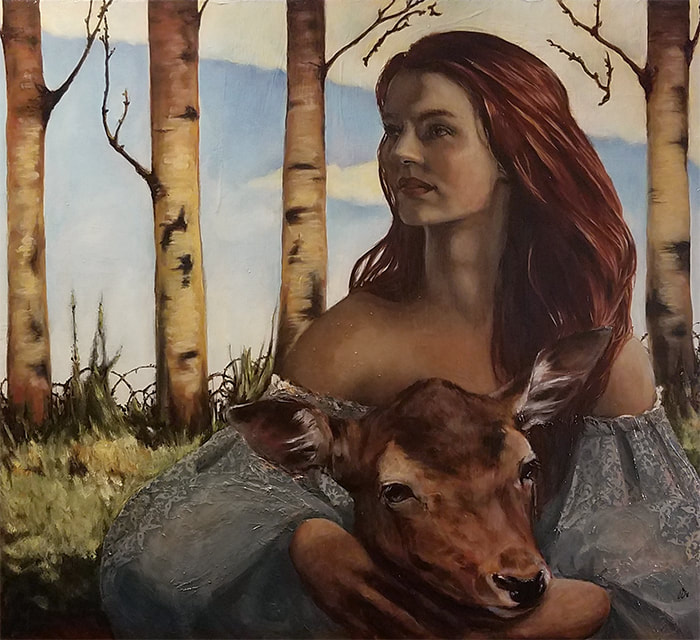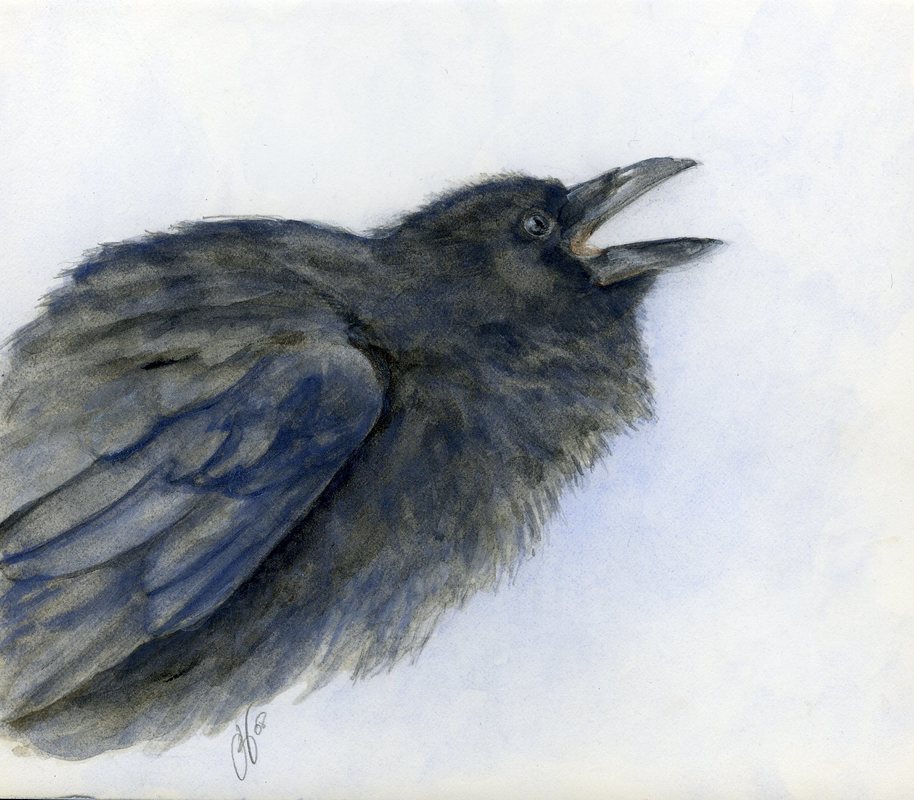|
About a week ago, I drafted up a post about my most recent painting, "St Thecla and the Deer", which is currently in France for the Chimeria event, which opens early October. The painting was created specifically for this event, which is themed by life-affirming mythology. I was given permission to pursue a Christian subject, and I believe I was the only artist to do so, but only because my case for St Thecla was so impassioned.
However, the post I wrote up was blighted by frustration, like a bad Irish potato. I won't deny that the painting was probably one of my most frustrating creations and even my humanist friends pondered whether it was cursed. Everything that could go wrong certainly did so. But I came at it with a sense of blame, fingering every nearby element as to why things went wrong, when, in actuality, the problem lay in the painting's intent. Let's start with the initial intent: St Thecla herself. St Thecla was an early Christian, a follower of St Paul. A member of the noble class in Turkey, Thecla overheard St Paul's gospel as she sat by a window in her home. Overcome by the Holy Spirit, she was so moved by the gospel of Christ that she denounced her engagement (she was a young girl with a hefty dowry) and chose instead to follow St Paul and the path of Christ. Her mother, furious, sent the authorities after her, and Thecla was arrested, her punishment being death by mauling of beasts. However, upon being thrust into a local coliseum ring, the female lions amongst the group of animals made a ring around her, protecting her, and her life was spared. Thecla was not a wilting flower; being very beautiful, she was often accosted by men during her wanderings, and had no problem staving them off on her own, with little help from St Paul or her other companions. Intelligent, well spoken, and deeply committed to the cause of Christianity, St Paul assigned her an Abbey and she became the first Abbess. In her 80s, her Abbey was attacked by marauding Arabs, and she was able to stave them off and save the Abbey. She was a popular saint up until the 10/11th centuries, when the Church felt she was an inappropriate female saint (versus, say, the Virgin Mary). She was too autonomous and headstrong of a figure, they felt, a poor role model for the weaker vessel, and she was wiped from Western gospels. If it weren't for the Orthodox church, she'd be a blip in Christian lore, but she remained a strong and steady saint in the eastern church, and in the last 50 years her cult has grown. In Christian symbolism, the deer represents chastity. St Thecla took an oath of chastity, even cut off her hair as a symbolic gesture. My painting represents the moment Thecla recognizes her calling. She holds a fallow deer in a field, with birch trees in the background and a large, looming cloud. She's mostly in shadow, the sunlight creeping up from behind her. Birch trees are not indigenous to Turkey, but I find them mysterious and interesting and fun to paint. There are brambles in the horizon that look a little like razor wire, representing her hardships to come, and the cloud veils the future. Her dress pattern vaguely resembles the female reproductive organs - I noticed this as I was painting it, it wasn't intended at first. All the things she sheds in life- marriage, children, dowry, family ties - these things were all that mattered to a young affluent woman of her culture, and she shed them all to serve the gospel of Christ. All the things that make her a pretty portrait are just an illusion. I intended to make the deer the most realistic part of the painting, even though it was the actual symbolic figure, in order to drive home the head-flip of fantasy and reality. So this, in a nutshell, was the original intent of the painting. I now see that the painting process was riddled with problems because my own state of mind was elsewhere, and that manifested as compositional mistakes, color palette problems, value issues, and finally actual weirdness like my brushes going missing (they were in a traveling case, and the thing disappeared for weeks, and popped back up literally an hour after completing the painting, in a bizarre location nowhere near my studio). The painting should have taken a few weeks to paint at the most, but it took nearly six months. While I was painting, I was dealing with the feels of closing my longtime gallery, detoxing off a medication I'd been on for years, having an Addisonian Crisis and hospitalized (adrenal failure), ending my tenure as a curator, moving my painting studio, fighting with the IRS over tax returns, and finding out our building was being sold. I also realized I couldn't travel to Sedan, France, to the opening of Chimeria, as my health won't allow it. The frustration, disappointment, and sadness veiled the clear path of creation, making the painting process a very rocky road. My mind buzzed the entire time I worked. I made the weirdest rookie mistakes again and again, often winding up sanding down the results and starting over. The fact that the painting came together at all is a miracle, and really came down to the last few painting sessions, the last few glazes. In hindsight I can see all the missteps, but while I was in the thick of it, I was blinded by the things swirling around me, completely unable to connect with the painting until the very end. Many of the things plaguing me at the time have since resolved themselves, or I've come to terms with. For me, the lesson of St Thecla was the reminder that there is a Bigger Picture; the tornadoes of Now don't represent the totality of a weather system, and even they have an expiration date. There's nothing wrong with disappointment or sadness, frustration, resentment: they're just feelings. But they can manifest themselves into a reality, gunking things up, especially if they manifest into the creative process. As I channeled all this into the painting sessions, I gave myself a far worse time than it could have been. And much worse, I missed out on the relationship I could have built with this painting.
0 Comments
The other night I had a strange dream, which I summarized and sent off to my friend, a Lakota Indian who happens to be rather good at analyzing dreams. He didn't interpret it, but asked me a series of questions that allowed me to unmask the dream's lesson, which was a pretty good one.
In the dream, there is a crow. This crow (whom I'll just refer to as Crow) starts a game of pulling young chicks out of nests, dropping them down to earth, then mauling them before biting their head's off. Crow seems to enjoy this gruesome bloodsport, and after a while the local bird community suffers a great loss in its next generation. I see Crow's game and am upset by it. He pulls down a young Robin chick, who is crying. He hasn't completely finished with a little finch chick, who is pretty much dead, so the Robin is hopping about in distress while Crow works on biting the finch's head off. I crouch down and pick up the Robin and carry it back to its tree and worried parents. I walk back to Crow and I scold him. I tell him that this game is terrible and destructive. Crow cocks his head and looks at me and I can tell he doesn't agree with me. Finished with the finch, he flies back to the Robin's nest to retrieve the little chick. I then wind up spending my time in wait, trying to catch him in the act and rescue the little chicks he steals. This is time consuming, and since Crow is wise on me, he devises little counter actions of his own. It becomes exhaustive on my part, and I realize I can't spend all my days spying on Crow. Since Crow is clearly unphased by his actions and consequences, and my counter to save the chicks isn't always successful, the only other option to end the game is to convince Crow to play another one. While the dream ended here, it made me realize that in life, you're going to come across situations that you find unjust, broken, dysfunctional, destructive. Your kneejerk response is to point out how wrong this is, or how wrong these people are. Often, you are met with opposition, anger, or simply nothing at all. Now you are at war. You fight the injustice, and sometimes you're successful, sometimes you're not, but it becomes a consuming battle. Crow is traditionally a very wise trickster. Trying to outwit Crow is a fruitless challenge. Going to war with Crow can also warrant results that are not in your favor. And really, locked in this situation, no one is happy. Taking the time to understand that the game he is playing, then devising a new game that satisfies those motives, will ultimately end the game. If Crow is convinced that there is something better to do with his time than steal chicks, he'll move on. He may never understand the vulgarity of his actions, he may never pay the price of killing little chicks for sport, but if the results stop the terrible injustice and bring about peace, its worth the effort. In this current day, the dream of Crow is a potent one, its strong medicine. It tells me that I need to explore other options in solving problems, and to do so, I need to better understand the motivations of those around me. If I want the world to be a healthier place, I have to work to find solutions that entice others enough to end their current dysfunctional ways. This is the hardest path to walk, but the most rewarding. |
AuthorJulie Baroh is a US artist, entrepreneur, and chronic chatterbox. Categories
All
Archives |


 RSS Feed
RSS Feed
